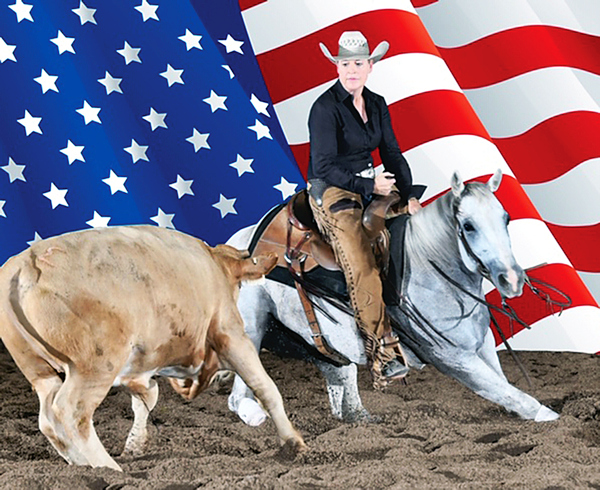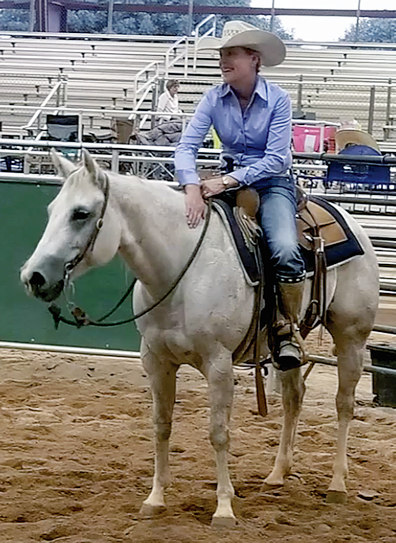By Heidi Dahms Foster
Virginia Kilduff of Prescott Valley grew up with horses, and learned from every one she rode. But it was in the past couple of years that she worked her way through some truly hard times with the help of her world champion cutting horse, Izzy.
Virginia got her first horse, a cantankerous Welsh pony, when she was 9. A less determined child might have been convinced to give up on horses. “I would pretty much work an hour to get her saddled, then ride a bit. Then she’d lay down and roll me off.”
Her next horse unwittingly set the stage for Virginia’s future sport. “He was much older, and a full-sized Quarter Horse. He was a “cattle bred” horse, a working ranch horse. She shadowed the trainer down the road, and began to compete in horse shows, gymkhanas, 4H and junior rodeo.
Virginia married her husband Tom, and the couple had two children, Justin and Sammie. They had purchased property in Prescott Valley, and in 1994, made the move north. By then, with raising two kids and having to haul water to their new property, Virginia had sold all but one of her horses. “We just wanted to move up north and raise the kids in a better place, so you put your dreams on hold,” she said.
In 2005, Virginia again began looking for another horse. At the same time, neighbors, cutting horse trainers, had moved in down the road and began to host “club cuttings.” “I was interested so we’d go over,” she said.
The sport of cutting was birthed in the real ranching West of the 1800s, where cowboys on their horses had to drift into a herd of cattle and “cut” out single animals for doctoring or branding, without upsetting the whole herd. It took an agile, cattle savvy horse that could move in calmly and yet turn on the speed when it was necessary to keep a cow from returning to the herd.

Today, cutting is a wildly popular sport among horse lovers, and an exciting one to watch. It’s also a beautiful picture of what a partnership between a rider and horse can look like.
In today’s cutting contests, each contestant enters the arena with a small herd of cattle and four helpers on horseback – two at the back of the herd to hold them in a group, and two in the front to turn back and help contain the herd.
The rider has two and a half minutes to move into the herd, decide on a cow that he or she believes will work best with the horse. The rider then moves the cow out to the center of the pen and controls it with the horse to keep it from returning to the herd. The rider can cut out and work with two or three cows within the time limit.
After watching her neighbors’ club cuttings, Virginia had her first chance to ride a turn back horse, and she was hooked. She bought her first real cutting horse in 2005. “I had a lot of fun with him, winning a bronze award at our year end club show.”
Over the next several years Virginia showed with several different horses, always improving in her sport. She soon moved to the larger National Cutting Horse Association shows.
“The competition there is as tough as it’s going to get,” she said, noting that because the sport is a partnership between horse and rider, and dealing with other live animals (the cattle), anything can and will happen on any given day.
“So many things can be out of your control,” she said. “You can be the best rider or trainer with the best horse, but that doesn’t mean you’ll win every time. It’s based on so many variables. You also have to have some luck. No run is ever the same – stay centered in the saddle, and ALWAYS keep your eye on the cow or you might end up on the ground, always exciting!”
She describes what it’s like to ride a good cutting horse. “Cutting pits a horse against a cow in a battle of wills. Horse and rider must move quietly into a herd of cattle, cut a cow from the herd, drive it to the center of the arena then ‘hold’ it away from the herd using only your legs and seat.
“The horse is scored on its ability to keep the cow from returning to the herd, cow sense, attentiveness and courage. The ideal picture of a cutting horse is one of polished concentration and split-second response to the action of the cow.
“Once the rider’s hand is lowered the rider’s role seems diminished, and it can look like the horse is working completely on his own. In reality, that illusion comes from a harmony of movement and a blending of responses between horse and rider,” she said.
The best cutting horses are what Virginia calls “cattle savvy.” “They have instinct. You can train a horse to work cattle, but the ones that have real cow horse sense enjoy the job. You can’t train that into them.”
In the past five years, Virginia started training with renowned cutting horse trainer Mike Wood from Rio Verde, Arizona. Wood has a knack, she said, for matching the right horse with the right rider, and she liked the way he and his team members managed the riders and horses they worked with.
She was riding a horse that better suited to another rider, and the two made a trade, in which she acquired her horse Jazzy, with whom she continued to perfect her sport. When it came time to retire the mare, she went to a friend of Virginia’s where she knew Jazzy would have a great home.
Virginia then found herself ready to hit the road again. Wood called her and told her about a horse that he thought would be a good fit. “JJ” took her to another level, and the pair won a large NCHA amateur show in Las Vegas. “He was a great horse, and a lot of fun. He developed some foot issues, which happens sometimes, and he came home to lounge with me.”
After a break in showing and traveling, Wood again called Virginia and told her of a horse that he thought she would enjoy riding. Kisses on My Bottom, or “Izzy,” was in Texas, and had been through nine different owners. Virginia trusted Wood’s judgment, so she began to look into Izzy. After extensive vet checks and video meetings, Izzy was judged sound and Virginia decided to take a chance on her.
In 2019, a friend of Woods brought Izzy to an Arizona show, and the two met. Virginia rode Izzy at that show, and found she was a sensitive mare and not in the best shape, but the two did well. “She was 10, and she had gone a lot of places. She had had some bad experiences, and horses are like elephants, they don’t forget. She had a lot of great owners, but sometimes horses find trouble. She was sweet and a very hard worker.”

The two became a team, and it looked as if the sky was the only limit. Izzy and Virginia became Circuit Champs in a five-day contest, then won their first prize saddle in a “shootout” competition.
At the same time she met Izzy, Virginia had a health scare, being diagnosed with a type of breast cancer. She had a biopsy, and thankfully all was fine. But in December 2019 her doctor told her she definitely had the cancer and would need surgery. She continued to compete with Izzy in January and February 2020, and then had surgery in March. By that time, Virginia and Izzy were at the top of the NCHA standings. Then, she said, the Pandemic hit and everything stopped. “It didn’t start up again until May 2020, and by that time, I was healed.”
Her health scare and her partnership with Izzy had Virginia viewing competition in a different way by then. “There’s a different attitude when the opposition is there. I’ve seen so many great horses and riders, but sometimes it still doesn’t work. This was working. We just clicked,” she said. “Izzy is special. She had some rough spells in her life, too. She’s tough, loves her job, and gives it 100 percent every time.”
During 2020, the pair traveled to Wyoming, Nevada, California, Arizona, New Mexico, Colorado and Texas to show. In December 2020, they landed in Las Vegas, Nevada for the NCHA World Finals. Both times in the arena, Virginia and Izzy drew and had to compete first (the luck of the draw). That didn’t leave time for Virginia to study the cows and see how they reacted. “I knew to just drive the cow far out into the arena so it would get back to the herd. I believe it is me and my horse against the cow, and I just wanted to get set up correctly,” she said.
The pair laid down a really nice first run, and on the second run got a bit out of position for a lower score, but the average was enough to propel Virginia and Izzy into the NCHA World Championship in the Non-Pro $35,000 class.
This year, Izzy and Virginia have continued to do so well that they are again on the top of the World NCHA standings. Izzy has settled and overcome some of her quirks, and Virginia has found that the mare has an affinity for Oreo cookies.
Virginia said she is at a place where she has realized her dreams in cutting competition, but the decision to retire or sell Izzy and move on is a hard one. Being away from home so much, and being on the road while working to keep her horse healthy and happy is not an easy journey.
“My plan was to meet this goal (the World Championship). Izzy made the dream come true, with a lot of work from a lot of people. You think you’re done, but I don’t think she’s done. She’s sound and healthy, and she keeps winning. And there’s a financial part to this. I could continue, but then you almost have to say ‘OK, let’s put all that money toward retirement grownup things.’”
Whatever she decides, Virginia will enjoy the memories of the special white horse that helped her through one of her hardest times. “When I was diagnosed, my parents were moving to Prescott, my son was getting married, and my daughter was graduating. I didn’t tell anyone then but Izzy. She was a great distraction!”


